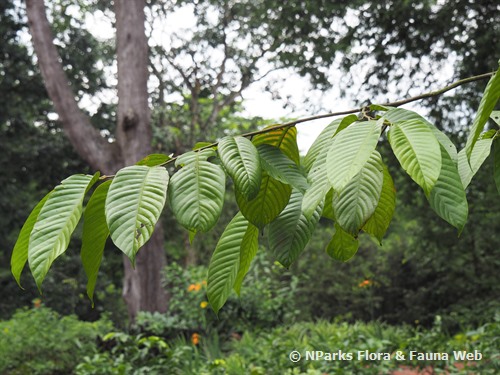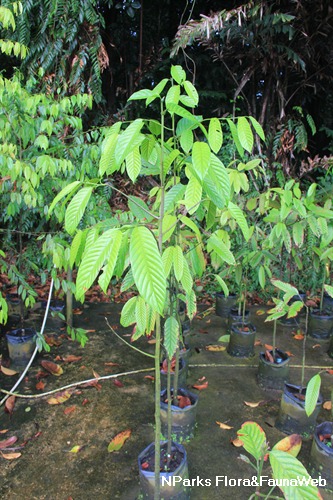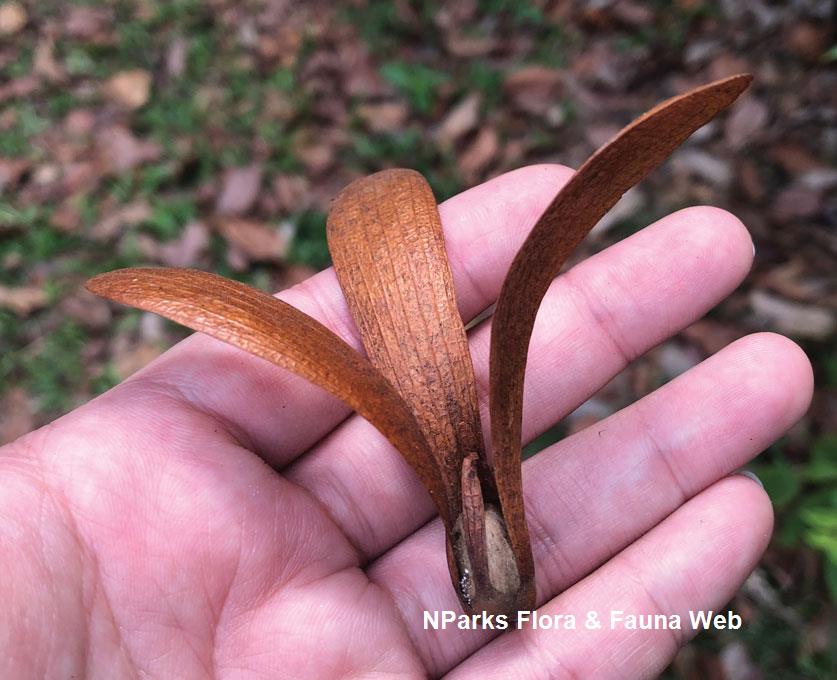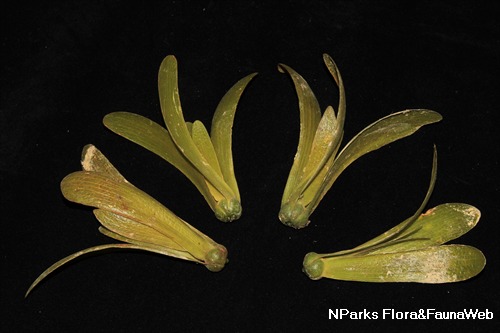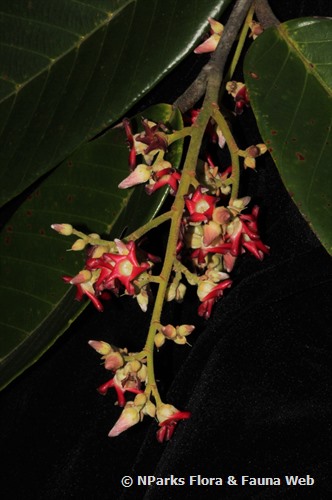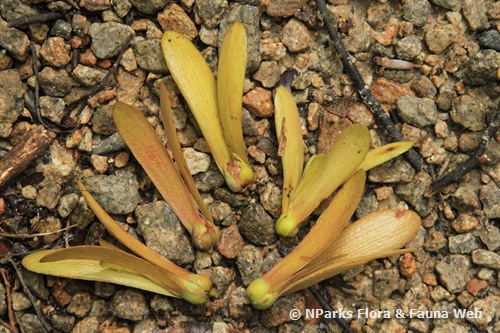
Back
Rubroshorea johorensis (Foxw.) P.S.Ashton & J.Heck.
| Family Name: | Dipterocarpaceae |
| Synonyms: | Shorea johorensis Foxw., Shorea leptoclados Symington |
| Common Name: | Meranti Pepijat, Majau, Seraya Majau, Meranti Majau |
Rubroshorea johorensis , also known as Meranti Pepijat is a critically endangered tree in Singapore. Growing up to 50 m tall, it has prominent scale-like domatia on its leaves and winged fruit. The wood is used for light construction, musical instruments and plywood.
Name
Classifications and Characteristics
| Plant Division | Angiosperms (Flowering Seed Plants) |
|---|---|
| Plant Growth Form | Tree |
| Lifespan (in Singapore) | Perennial |
| Mode of Nutrition | Autotrophic |
| Plant Shape | Broad / Mushroom / Hemispherical |
| Maximum Height | 50 m |
Biogeography
| Native Distribution | Peninsular Malaysia, Singapore Sumatra and Borneo |
|---|---|
| Native Habitat | Terrestrial |
| Preferred Climate Zone | Tropical |
| Local Conservation Status | Native to Singapore (Critically Endangered (CR)) |
Description and Ethnobotany
| Growth Form | It is a tree, up to 50 m tall, and 1.6 m diameter. It has large and hemispherical crown, and buttresses up to 3 m tall. |
|---|---|
| Foliage | The leaves are oval shaped (9 – 14 cm long and 4.2 – 7.5 cm wide.), papery to thinly leathery and in alternate arrangement. The leaf tip is shortly pointed (up to 7 mm long) while the leaf base is obtuse. Each leaf has 10 – 12 pairs of lateral veins which are faintly visible above while prominently visible on the underside. The first 3 - 6 pairs of lateral veins usually have prominent scale-like domatia and the basal 2 pairs are fused along the midrib on each side. The tertiary veins are ladder-like (scalariform). Stipule is lanceolate and small (0.35 cm long and 0.07 cm wide), and the petiole is about 1.5 – 2 cm long. Short persistent grey hairs are found on the twigs, flower stalks, leaf buds, stipules, petioles, midrib on the upper side of the leaf as well as the lateral veins on underside of the leaves. |
| Flowers | Inflorescence is about 15 cm long and slightly pendulous. Each branchlet bears up to 18 secund flowers. Petals are pale yellow and densely hairy on the parts that are exposed in bud. Each flower has 15 stamens with oblong anthers. The connectival appendage is glabrous and 3 times as long as the anther. Ovary is globose. Style is thread-like (filiform) and twice as long as the ovary. Stylopodium is indistinct. |
| Fruit | The fruit is winged and dry. They are borne on stalk which are 4 – 5mm long. Each fruit comprises of three long calyx lobes (up to 12 cm long and 2.3 cm wide), two shorter lobes (up to 6.5 cm long and 0.6 cm wide) and one oval-shaped nut (2 cm long and 1.4 cm wide) with a short style remnant at the tip. |
| Habitat | It is found in lowland rainforests on well-drained and gently undulating terrain, up to 600 m altitude. |
| Similar | Rubroshorea johorensis is similar to Rubroshorea pauciflora (synonym: Shorea pauciflora). Foliage, floral and fruit features are key to tell them apart. R. johorensis usually has scale-like domatia at the base of the first 3 – 6 pairs of lateral veins, the connectival appendages are glabrous, and fruits are prominently stalked. While R. pauciflora occasionally have a few glabrous domatia, the connectival appendages are bristle-like towards the tip and fruits are subsessile. |
| Associated Fauna | Flowers are pollinated by insects. |
| Cultivation | It can be propagated by seed. |
| Etymology | The specific epithet johorensis, refers to Johor, Peninsular Malaysia, one of the places where it occurs naturally. |
| Ethnobotanical Uses | Timber & Products: The timber is used as light red meranti. It is used for light construction such as light-duty flooring, shelves, musical instruments, coffins, toys and wooden matches. It is also used to make plywood, both as face and core veneer. |
Landscaping Features
| Landscape Uses | Parks & Gardens, Reforestation |
|---|
Fauna, Pollination and Dispersal
| Pollination Method(s) | Biotic (Fauna) |
|---|---|
| Seed or Spore Dispersal | Abiotic |
Plant Care and Propagation
| Light Preference | Full Sun |
|---|---|
| Water Preference | Moderate Water |
| Plant Growth Rate | Moderate |
| Rootzone Tolerance | Well-Drained Soils |
| Propagation Method | Seed |
Foliar
| Foliage Retention | Evergreen |
|---|---|
| Mature Foliage Colour(s) | Green |
| Mature Foliage Texture(s) | Papery, Leathery |
| Foliar Type | Simple / Unifoliate |
| Foliar Arrangement Along Stem | Alternate |
| Foliar Attachment to Stem | Petiolate |
| Foliar Shape(s) | Non-Palm Foliage (Oval) |
| Foliar Venation | Pinnate / Net |
| Foliar Margin | Entire |
| Foliar Apex - Tip | Acuminate |
| Foliar Base | Rounded / Obtuse |
Non - Foliar and Storage
| Trunk Type (Non Palm) | Woody |
|---|---|
| Mature Bark Texture | Cracked |
| Stem Type & Modification | Woody |
| Root Type | Underground |
Floral (Angiosperm)
| Flower & Plant Sexuality | Bisexual Flowers , Bisexual Flowers |
| Flower Colour(s) | Cream / Off-White |
|---|
| Flower Grouping | Cluster / Inflorescence |
| Flower Location | Axillary, Terminal |
| Flower Symmetry | Radial |
| Individual Flower Shape | Saucer-shaped |
| Inflorescence Type | Panicle |
| Flowering Period | Every Few Years |
| Flowering Habit | Polycarpic |
Fruit, Seed and Spore
| Mature Fruit Colour(s) | Brown |
|---|---|
| Fruit Classification | Simple Fruit |
| Fruit Type | Indehiscent Dry Fruit , Nut / Nutlet |
| Seed Quantity Per Fruit | Few (1-5) |
References
| References | Ashton, P.S. (1982). Dipterocarpaceae. In: van Steenis, C.G.G.J. (ed.) Flora Malesiana, ser.1,vol. 9, part 2, pp. 237–552, 575–600. The Hague/Boston/London: Martinus Nijhoff/Dr. W. Junk Publishers. Ganesan, S.K., Lua, H.K. & Ibrahim, A. (2018). Shorea johorensis (Dipterocarpaceae), an addition to the flora of Singapore. Gardens' Bulletin Singapore 70 (1): 19–23. Soerianegara, I., and Lemmens, R.H.M.J. (Editors). 1993. Plant Resources of South-East Asia Volume 5 (1). Timber Trees: Major Commercial Timbers. Netherlands: Pudoc Scientific Publishers. 610 pages. |
|---|
Image Repository
Others
| Master ID | 33397 |
|---|---|
| Species ID | 7811 |
| Flora Disclaimer | The information in this website has been compiled from reliable sources, such as reference works on medicinal plants. It is not a substitute for medical advice or treatment and NParks does not purport to provide any medical advice. Readers should always consult his/her physician before using or consuming a plant for medicinal purposes. |


